
Calculus Volume 2
17th Edition
ISBN: 9781938168062
Author: Gilbert Strang, Edwin Jed Herman
Publisher: OpenStax
expand_more
expand_more
format_list_bulleted
Concept explainers
Textbook Question
Chapter 4.2, Problem 88E
Match the direction field with the given differential equations. Explain your selections.
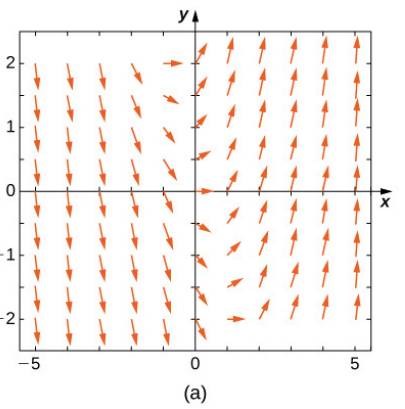
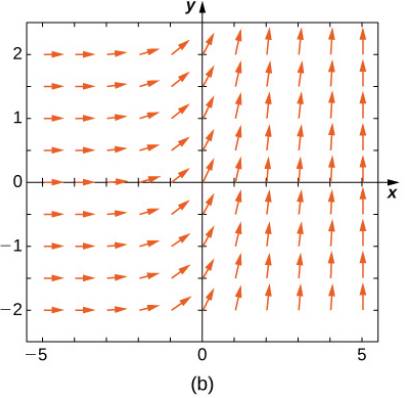
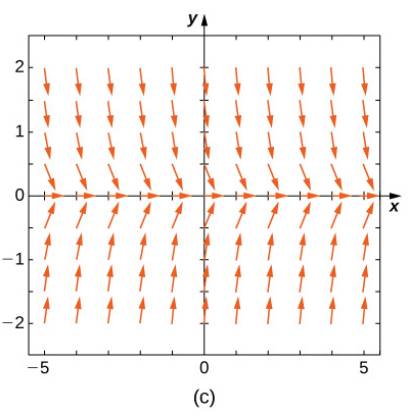
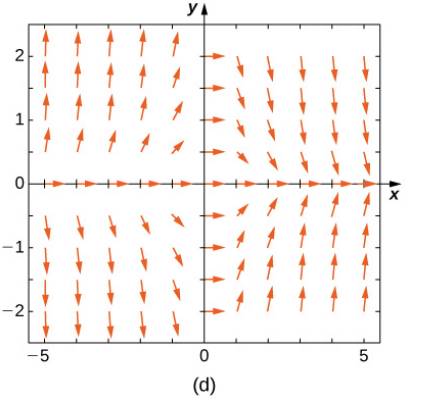
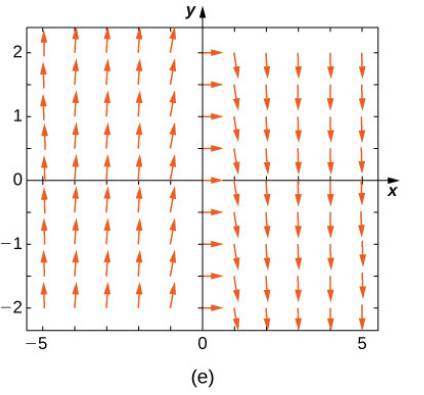
89.
Expert Solution & Answer
Trending nowThis is a popular solution!

Students have asked these similar questions
Find the indefinite integral by making a change of variables. (Remember the constant of integration.)
√(x+4)
4)√6-x dx
InThe Northern Lights are bright flashes of colored light between 50 and 200 miles above Earth.
Suppose a flash occurs 150 miles above Earth. What is the measure of arc BD, the portion of Earth
from which the flash is visible? (Earth’s radius is approximately 4000 miles.)
Ju
at
© Ju
370
= x (-
пье
zxp
= c² (2² 4 )
dx²
ахе
2
nze
dyz
t
nzp
Q/what type of partial differential equation (PDE)
are the following-
Chapter 4 Solutions
Calculus Volume 2
Ch. 4.1 - Determine the order of the following differential...Ch. 4.1 - Determine the order of the following differential...Ch. 4.1 - Determine the order of the following differential...Ch. 4.1 - Determine the order of the following differential...Ch. 4.1 - Determine the order of the following differential...Ch. 4.1 - Determine the order of the following differential...Ch. 4.1 - Determine the order of the following differential...Ch. 4.1 - Verify that the following functions are solutions...Ch. 4.1 - Verify that the following functions are solutions...Ch. 4.1 - Verify that the following functions are solutions...
Ch. 4.1 - Verify that the following functions are solutions...Ch. 4.1 - Verify that the following functions are solutions...Ch. 4.1 - Verify that the following functions are solutions...Ch. 4.1 - Verify that the following functions are solutions...Ch. 4.1 - Verify that the following functions are solutions...Ch. 4.1 - Verify that the following functions are solutions...Ch. 4.1 - Verify that the following functions are solutions...Ch. 4.1 - Verify the following general solutions and find...Ch. 4.1 - Verify the following general solutions and find...Ch. 4.1 - Verify the following general solutions and find...Ch. 4.1 - Verify the following general solutions and find...Ch. 4.1 - Verify the following general solutions and find...Ch. 4.1 - Verify the following general solutions and find...Ch. 4.1 - Verify the following general solutions and find...Ch. 4.1 - Verify the following general solutions and find...Ch. 4.1 - Verify the following general solutions and find...Ch. 4.1 - Verify the following general solutions and find...Ch. 4.1 - For the following problems, find the general...Ch. 4.1 - For the following problems, find the general...Ch. 4.1 - For the following problems, find the general...Ch. 4.1 - For the following problems, find the general...Ch. 4.1 - For the following problems, find the general...Ch. 4.1 - For the following problems, find the general...Ch. 4.1 - For the following problems, find the general...Ch. 4.1 - For the following problems, find the general...Ch. 4.1 - For the following problems, find the general...Ch. 4.1 - For the following problems, find the general...Ch. 4.1 - Solve the following initial-value problems...Ch. 4.1 - Solve the following initial-value problems...Ch. 4.1 - Solve the following initial-value problems...Ch. 4.1 - Solve the following initial-value problems...Ch. 4.1 - Solve the following initial-value problems...Ch. 4.1 - Solve the following initial-value problems...Ch. 4.1 - Solve the following initial-value problems...Ch. 4.1 - Solve the following initial-value problems...Ch. 4.1 - Solve the following initial-value problems...Ch. 4.1 - Solve the following initial-value problems...Ch. 4.1 - Recall that a family of solutions includes...Ch. 4.1 - Recall that a family of solutions includes...Ch. 4.1 - Recall that a family of solutions includes...Ch. 4.1 - Recall that a family of solutions includes...Ch. 4.1 - Recall that a family of solutions includes...Ch. 4.1 - Recall that a family of solutions includes...Ch. 4.1 - Recall that a family of solutions includes...Ch. 4.1 - Recall that a family of solutions includes...Ch. 4.1 - Recall that a family of solutions includes...Ch. 4.1 - Recall that a family of solutions includes...Ch. 4.1 - Recall that a family of solutions includes...Ch. 4.1 - Recall that a family of solutions includes...Ch. 4.1 - Recall that a family of solutions includes...Ch. 4.1 - Recall that a family of solutions includes...Ch. 4.1 - Recall that a family of solutions includes...Ch. 4.1 - Recall that a family of solutions includes...Ch. 4.1 - Recall that a family of solutions includes...Ch. 4.1 - Recall that a family of solutions includes...Ch. 4.2 - For the following problems, use the direction...Ch. 4.2 - For the following problems, use the direction...Ch. 4.2 - For the following problems, use the direction...Ch. 4.2 - For the following problems, use the direction...Ch. 4.2 - For the following problems, use the direction...Ch. 4.2 - For the following problems, use the direction...Ch. 4.2 - For the following problems, use the direction...Ch. 4.2 - For the following problems, use the direction...Ch. 4.2 - Draw the direction field for the following...Ch. 4.2 - Draw the direction field for the following...Ch. 4.2 - Draw the direction field for the following...Ch. 4.2 - Draw the direction field for the following...Ch. 4.2 - Draw the direction field for the following...Ch. 4.2 - Draw the directional field for the following...Ch. 4.2 - Draw the directional field for the following...Ch. 4.2 - Draw the directional field for the following...Ch. 4.2 - Draw the directional field for the following...Ch. 4.2 - Draw the directional field for the following...Ch. 4.2 - Match the direction field with the given...Ch. 4.2 - Match the direction field with the given...Ch. 4.2 - Match the direction field with the given...Ch. 4.2 - Match the direction field with the given...Ch. 4.2 - Match the direction field with the given...Ch. 4.2 - Match the direction field with the given...Ch. 4.2 - Match the direction field with the given...Ch. 4.2 - Match the direction field with the given...Ch. 4.2 - Match the direction field with the given...Ch. 4.2 - Match the direction field with the given...Ch. 4.2 - Estimate the following solutions using Euler’s...Ch. 4.2 - Estimate the following solutions using Euler’s...Ch. 4.2 - WEstimate the following solutions using Euler’s...Ch. 4.2 - Estimate the following solutions using Euler’s...Ch. 4.2 - Estimate the following solutions using Euler’s...Ch. 4.2 - Estimate the following solutions using Euler’s...Ch. 4.2 - Estimate the following solutions using Euler’s...Ch. 4.2 - Estimate the following solutions using Euler’s...Ch. 4.2 - Estimate the following solutions using Euler’s...Ch. 4.2 - Estimate the following solutions using Euler’s...Ch. 4.2 - Differential equations can be used to model...Ch. 4.2 - Differential equations can be used to model...Ch. 4.2 - Differential equations can be used to model...Ch. 4.2 - Differential equations can be used to model...Ch. 4.2 - Differential equations can be used to model...Ch. 4.2 - Differential equations can be used to model...Ch. 4.2 - Differential equations can be used to model...Ch. 4.2 - Differential equations can be used to model...Ch. 4.2 - Differential equations can be used to model...Ch. 4.2 - Differential equations can be used to model...Ch. 4.2 - Consider the initial-value problem y' = 2y, y(0) =...Ch. 4.2 - Consider the initial-value problem y' = 2y, y(0) =...Ch. 4.2 - Consider the initial-value problem y' = 2y, y(0) =...Ch. 4.2 - Consider the initial-value problem y' = 2y, y(0) =...Ch. 4.2 - Consider the initial-value problem y' = 2y, y(0) =...Ch. 4.3 - Solve the following initial-value problems with...Ch. 4.3 - Solve the following initial-value problems with...Ch. 4.3 - Solve the following initial-value problems with...Ch. 4.3 - Solve the following initial-value problems with...Ch. 4.3 - Find the general solution to the differential...Ch. 4.3 - Find the general solution to the differential...Ch. 4.3 - Find the general solution to the differential...Ch. 4.3 - Find the general solution to the differential...Ch. 4.3 - Find the general solution to the differential...Ch. 4.3 - Find the general solution to the differential...Ch. 4.3 - Find the general solution to the differential...Ch. 4.3 - Find the general solution to the differential...Ch. 4.3 - Find the general solution to the differential...Ch. 4.3 - Find the general solution to the differential...Ch. 4.3 - Find the solution to the initial-value problem....Ch. 4.3 - Find the solution to the initial-value problem....Ch. 4.3 - Find the solution to the initial-value problem....Ch. 4.3 - Find the solution to the initial-value problem....Ch. 4.3 - Find the solution to the initial-value problem....Ch. 4.3 - Find the solution to the initial-value problem....Ch. 4.3 - Find the solution to the initial-value problem....Ch. 4.3 - Find the solution to the initial-value problem....Ch. 4.3 - Find the solution to the initial-value problem....Ch. 4.3 - Find the solution to the initial-value problem....Ch. 4.3 - For the following problems, use a software program...Ch. 4.3 - For the following problems, use a software program...Ch. 4.3 - For the following problems, use a software program...Ch. 4.3 - For the following problems, use a software program...Ch. 4.3 - For the following problems, use a software program...Ch. 4.3 - Most drugs in the bloodstream decay according to...Ch. 4.3 - A drug is administered intravenously to a patient...Ch. 4.3 - [T] How often should a drug be taken if its dose...Ch. 4.3 - A tank contains 1 kilogram of salt dissolved in...Ch. 4.3 - A tank containing 10 kilograms of salt dissolved...Ch. 4.3 - [T] For the preceding problem, find flow much salt...Ch. 4.3 - Torricelli’s law states that for a water tank with...Ch. 4.3 - For the preceding problem, determine how long it...Ch. 4.3 - For the following problems, use Newton’s law of...Ch. 4.3 - For the following problems, use Newton’s law of...Ch. 4.3 - For the following problems, use Newton’s law of...Ch. 4.3 - For the following problems, use Newton’s law of...Ch. 4.3 - For the following problems, use Newton’s law of...Ch. 4.3 - For the following problems, use Newton’s law of...Ch. 4.3 - For the following problems, use Newton’s law of...Ch. 4.3 - For the following problems, use Newton’s law of...Ch. 4.3 - For the following problems, use Newton’s law of...Ch. 4.3 - For the following problems, use Newton’s law of...Ch. 4.3 - For the following problems, use Newton’s law of...Ch. 4.3 - For the following problems, use Newton’s law of...Ch. 4.4 - Student Project: Logistic Equation with a...Ch. 4.4 - Student Project: Logistic Equation with a...Ch. 4.4 - Student Project: Logistic Equation with a...Ch. 4.4 - Student Project: Logistic Equation with a...Ch. 4.4 - For the following problems, consider the logistic...Ch. 4.4 - For the following problems, consider the logistic...Ch. 4.4 - For the following problems, consider the logistic...Ch. 4.4 - For the following problems, consider the logistic...Ch. 4.4 - For the following problems, consider the logistic...Ch. 4.4 - A population of deer inside a park has a carrying...Ch. 4.4 - A population of frogs in a pond has a growth rate...Ch. 4.4 - [T] Bacteria grow at a rate of 2O per hour in a...Ch. 4.4 - [T] Rabbits in a park have an initial population...Ch. 4.4 - [T] Two monkeys are placed on an island. After 5...Ch. 4.4 - [T] A butterfly sanctuary is built that can hold...Ch. 4.4 - The following problems consider the logistic...Ch. 4.4 - The following problems consider the logistic...Ch. 4.4 - The following problems consider the logistic...Ch. 4.4 - The following problems consider the logistic...Ch. 4.4 - The following problems consider the logistic...Ch. 4.4 - It is more likely that the amount of fishing is...Ch. 4.4 - It is more likely that the amount of fishing is...Ch. 4.4 - It is more likely that the amount of fishing is...Ch. 4.4 - It is more likely that the amount of fishing is...Ch. 4.4 - It is more likely that the amount of fishing is...Ch. 4.4 - The following problems add in a minimal threshold...Ch. 4.4 - The following problems add in a minimal threshold...Ch. 4.4 - The following problems add in a minimal threshold...Ch. 4.4 - The following problems add in a minimal threshold...Ch. 4.4 - The following problems add in a minimal threshold...Ch. 4.4 - The following questions consider the Gompertz...Ch. 4.4 - The following questions consider the Gompertz...Ch. 4.4 - The following questions consider the Gompertz...Ch. 4.4 - The following questions consider the Gompertz...Ch. 4.4 - The following questions consider the Gompertz...Ch. 4.4 - The following questions consider the Gompertz...Ch. 4.4 - The following questions consider the Gompertz...Ch. 4.4 - The following questions consider the Gompertz...Ch. 4.4 - The following questions consider the Gompertz...Ch. 4.4 - Below is a table of the populations of whooping...Ch. 4.4 - Below is a table of the populations of whooping...Ch. 4.4 - Below is a table of the populations of whooping...Ch. 4.4 - Below is a table of the populations of whooping...Ch. 4.4 - Below is a table of the populations of whooping...Ch. 4.5 - Are the following differential equations linear?...Ch. 4.5 - Are the following differential equations linear?...Ch. 4.5 - Are the following differential equations linear?...Ch. 4.5 - Are the following differential equations linear?...Ch. 4.5 - Are the following differential equations linear?...Ch. 4.5 - Write the following first-order differential...Ch. 4.5 - Write the following first-order differential...Ch. 4.5 - Write the following first-order differential...Ch. 4.5 - Write the following first-order differential...Ch. 4.5 - Write the following first-order differential...Ch. 4.5 - What are the integrating factors for the following...Ch. 4.5 - What are the integrating factors for the following...Ch. 4.5 - What are the integrating factors for the following...Ch. 4.5 - What are the integrating factors for the following...Ch. 4.5 - What are the integrating factors for the following...Ch. 4.5 - Solve the following differential equations by...Ch. 4.5 - Solve the following differential equations by...Ch. 4.5 - Solve the following differential equations by...Ch. 4.5 - Solve the following differential equations by...Ch. 4.5 - Solve the following differential equations by...Ch. 4.5 - Solve the following differential equations by...Ch. 4.5 - Solve the following differential equations by...Ch. 4.5 - Solve the following differential equations by...Ch. 4.5 - Solve the following differential equations by...Ch. 4.5 - Solve the following differential equations by...Ch. 4.5 - Solve the following differential equations. Use...Ch. 4.5 - Solve the following differential equations. Use...Ch. 4.5 - Solve the following differential equations. Use...Ch. 4.5 - Solve the following differential equations. Use...Ch. 4.5 - Solve the following differential equations. Use...Ch. 4.5 - Solve the following differential equations. Use...Ch. 4.5 - Solve the following differential equations. Use...Ch. 4.5 - Solve the following differential equations. Use...Ch. 4.5 - Solve the following initial-value problems by...Ch. 4.5 - Solve the following initial-value problems by...Ch. 4.5 - Solve the following initial-value problems by...Ch. 4.5 - Solve the following initial-value problems by...Ch. 4.5 - Solve the following initial-value problems by...Ch. 4.5 - Solve the following initial-value problems by...Ch. 4.5 - Solve the following initial-value problems by...Ch. 4.5 - Solve the following initial-value problems by...Ch. 4.5 - Solve the following initial-value problems by...Ch. 4.5 - Solve the following initial-value problems by...Ch. 4.5 - A falling object of mass m can reach terminal...Ch. 4.5 - Using your expression from the preceding problem,...Ch. 4.5 - [T] Using your equation for terminal velocity,...Ch. 4.5 - A more accurate way to describe terminal velocity...Ch. 4.5 - Using your expression from the preceding problem,...Ch. 4.5 - [T] Using your equation for terminal velocity,...Ch. 4.5 - For the following problems, determine how...Ch. 4.5 - For the following problems, determine how...Ch. 4.5 - For the following problems, determine how...Ch. 4.5 - For the following problems, determine how...Ch. 4.5 - For the following problems, determine how...Ch. 4 - True or False? Justify your answer with a proof or...Ch. 4 - True or False? Justify your answer with a proof or...Ch. 4 - True or False? Justify your answer with a proof or...Ch. 4 - True or False? Justify your answer with a proof or...Ch. 4 - For the following problems, find the general...Ch. 4 - For the following problems, find the general...Ch. 4 - For the following problems, find the general...Ch. 4 - For the following problems, find the general...Ch. 4 - For the following problems, find the general...Ch. 4 - For the following problems, find the general...Ch. 4 - For the following problems, find the solution to...Ch. 4 - For the following problems, find the solution to...Ch. 4 - For the following problems, find the solution to...Ch. 4 - For the following problems, find the solution to...Ch. 4 - For the following problems, find the solution to...Ch. 4 - For the following problems, find the solution to...Ch. 4 - For the following problems, draw the directional...Ch. 4 - For the following problems, draw the directional...Ch. 4 - For the following problems, use Euler’s Method...Ch. 4 - For the following problems, use Euler’s Method...Ch. 4 - For the following problems, set up and solve the...Ch. 4 - For the following problems, set up and solve the...Ch. 4 - For the following problems, set up and solve the...Ch. 4 - For the following problems, set up and solve the...Ch. 4 - For the following problems, set up and solve the...Ch. 4 - For the following problems, set up and solve the...Ch. 4 - For the following problems, set up and solve the...Ch. 4 - For the following problems, set up and solve the...Ch. 4 - For the following problems, set up and solve the...
Additional Math Textbook Solutions
Find more solutions based on key concepts
Derivatives involving ln x Find the following derivatives. 17. ddx((x2+1)lnx)
Calculus: Early Transcendentals (2nd Edition)
TRY IT YOURSELF 1
Find the mean of the points scored by the 51 winning teams listed on page 39.
Elementary Statistics: Picturing the World (7th Edition)
A pair of fair dice is rolled. What is the probability that the second die lands on a higher value than does th...
A First Course in Probability (10th Edition)
25. Eye Contact In a study of facial behavior, people in a control group are timed for eye contact in a 5-minut...
Elementary Statistics (13th Edition)
Assessment 1-1A The following is a magic square all rows, columns, and diagonals sum to the same number. Find t...
A Problem Solving Approach To Mathematics For Elementary School Teachers (13th Edition)
Knowledge Booster
Learn more about
Need a deep-dive on the concept behind this application? Look no further. Learn more about this topic, subject and related others by exploring similar questions and additional content below.Similar questions
- Use Green's Theorem to evaluate F. dr, where F = (√+4y, 2x + √√) and C consists of the arc of the curve y = 4x - x² from (0,0) to (4,0) and the line segment from (4,0) to (0,0).arrow_forwardWhen a tennis player serves, he gets two chances to serve in bounds. If he fails to do so twice, he loses the point. If he attempts to serve an ace, he serves in bounds with probability 3/8.If he serves a lob, he serves in bounds with probability 7/8. If he serves an ace in bounds, he wins the point with probability 2/3. With an in-bounds lob, he wins the point with probability 1/3. If the cost is '+1' for each point lost and '-1' for each point won, the problem is to determine the optimal serving strategy to minimize the (long-run)expected average cost per point. (Hint: Let state 0 denote point over,two serves to go on next point; and let state 1 denote one serve left. (1). Formulate this problem as a Markov decision process by identifying the states and decisions and then finding the Cik. (2). Draw the corresponding state action diagram. (3). List all possible (stationary deterministic) policies. (4). For each policy, find the transition matrix and write an expression for the…arrow_forwardDuring each time period, a potential customer arrives at a restaurant with probability 1/2. If there are already two people at the restaurant (including the one being served), the potential customer leaves the restaurant immediately and never returns. However, if there is one person or less, he enters the restaurant and becomes an actual customer. The manager has two types of service configurations available. At the beginning of each period, a decision must be made on which configuration to use. If she uses her "slow" configuration at a cost of $3 and any customers are present during the period, one customer will be served and leave with probability 3/5. If she uses her "fast" configuration at a cost of $9 and any customers are present during the period, one customer will be served and leave with probability 4/5. The probability of more than one customer arriving or more than one customer being served in a period is zero. A profit of $50 is earned when a customer is served. The manager…arrow_forward
- Every Saturday night a man plays poker at his home with the same group of friends. If he provides refreshments for the group (at an expected cost of $14) on any given Saturday night, the group will begin the following Saturday night in a good mood with probability 7/8 and in a bad mood with probability 1/8. However, if he fail to provide refreshments, the group will begin the following Saturday night in a good mood with probability 1/8 and in a bad mood with probability 7/8 regardless of their mood this Saturday. Furthermore, if the group begins the night in a bad mood and then he fails to provide refreshments, the group will gang up on him so that he incurs expected poker losses of $75. Under other circumstances he averages no gain or loss on his poker play. The man wishes to find the policy regarding when to provide refreshments that will minimize his (long-run) expected average cost per week. (1). Formulate this problem as a Markov decision process by identifying the states and…arrow_forwardThis year Amanda decides to invest in two different no-load mutual funds: the G Fund or the L Mutual Fund. At the end of each year, she liquidates her holdings, takes her profits, and then reinvests. The yearly profits of the mutual funds depend on where the market stood at the end of the preceding year. Recently the market has been oscillating around level 2 from one year end to the next, according to the probabilities given in the following transition matrix : L1 L2 L3 L1 0.2 0.4 0.4 L2 0.1 0.4 0.5 L3 0.3 0.3 0.4 Each year that the market moves up (down) 1 level, the G Fund has profits (losses) of $20k, while the L Fund has profits (losses) of $10k. If the market moves up (down) 2 level in a year, the G Fund has profits (losses) of $50k, while the L Fund has profits (losses) of only $20k. If the market does not change, there is no profit or loss for either fund. Amanda wishes to determine her optimal investment policy in order to maximize her (long-run) expected average profit per…arrow_forwardEvaluate F. dr where F(x, y, z) = (2yz cos(xyz), 2xzcos(xyz), 2xy cos(xyz)) and C is the line π 1 1 segment starting at the point (8, ' and ending at the point (3, 2 3'6arrow_forward
- Solve this questions pleasearrow_forwardFind all positive integers n such that n.2n +1 is a square.arrow_forwardA researcher wishes to estimate, with 90% confidence, the population proportion of adults who support labeling legislation for genetically modified organisms (GMOs). Her estimate must be accurate within 4% of the true proportion. (a) No preliminary estimate is available. Find the minimum sample size needed. (b) Find the minimum sample size needed, using a prior study that found that 65% of the respondents said they support labeling legislation for GMOs. (c) Compare the results from parts (a) and (b). ... (a) What is the minimum sample size needed assuming that no prior information is available? n = (Round up to the nearest whole number as needed.)arrow_forward
arrow_back_ios
SEE MORE QUESTIONS
arrow_forward_ios
Recommended textbooks for you
 Discrete Mathematics and Its Applications ( 8th I...MathISBN:9781259676512Author:Kenneth H RosenPublisher:McGraw-Hill Education
Discrete Mathematics and Its Applications ( 8th I...MathISBN:9781259676512Author:Kenneth H RosenPublisher:McGraw-Hill Education Mathematics for Elementary Teachers with Activiti...MathISBN:9780134392790Author:Beckmann, SybillaPublisher:PEARSON
Mathematics for Elementary Teachers with Activiti...MathISBN:9780134392790Author:Beckmann, SybillaPublisher:PEARSON
 Thinking Mathematically (7th Edition)MathISBN:9780134683713Author:Robert F. BlitzerPublisher:PEARSON
Thinking Mathematically (7th Edition)MathISBN:9780134683713Author:Robert F. BlitzerPublisher:PEARSON Discrete Mathematics With ApplicationsMathISBN:9781337694193Author:EPP, Susanna S.Publisher:Cengage Learning,
Discrete Mathematics With ApplicationsMathISBN:9781337694193Author:EPP, Susanna S.Publisher:Cengage Learning, Pathways To Math Literacy (looseleaf)MathISBN:9781259985607Author:David Sobecki Professor, Brian A. MercerPublisher:McGraw-Hill Education
Pathways To Math Literacy (looseleaf)MathISBN:9781259985607Author:David Sobecki Professor, Brian A. MercerPublisher:McGraw-Hill Education

Discrete Mathematics and Its Applications ( 8th I...
Math
ISBN:9781259676512
Author:Kenneth H Rosen
Publisher:McGraw-Hill Education

Mathematics for Elementary Teachers with Activiti...
Math
ISBN:9780134392790
Author:Beckmann, Sybilla
Publisher:PEARSON


Thinking Mathematically (7th Edition)
Math
ISBN:9780134683713
Author:Robert F. Blitzer
Publisher:PEARSON

Discrete Mathematics With Applications
Math
ISBN:9781337694193
Author:EPP, Susanna S.
Publisher:Cengage Learning,

Pathways To Math Literacy (looseleaf)
Math
ISBN:9781259985607
Author:David Sobecki Professor, Brian A. Mercer
Publisher:McGraw-Hill Education
01 - What Is A Differential Equation in Calculus? Learn to Solve Ordinary Differential Equations.; Author: Math and Science;https://www.youtube.com/watch?v=K80YEHQpx9g;License: Standard YouTube License, CC-BY
Higher Order Differential Equation with constant coefficient (GATE) (Part 1) l GATE 2018; Author: GATE Lectures by Dishank;https://www.youtube.com/watch?v=ODxP7BbqAjA;License: Standard YouTube License, CC-BY
Solution of Differential Equations and Initial Value Problems; Author: Jefril Amboy;https://www.youtube.com/watch?v=Q68sk7XS-dc;License: Standard YouTube License, CC-BY